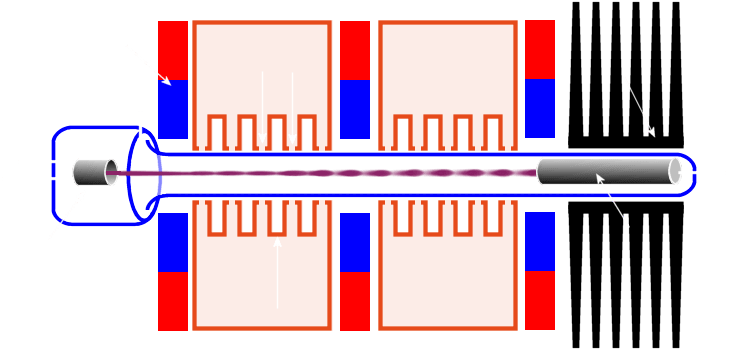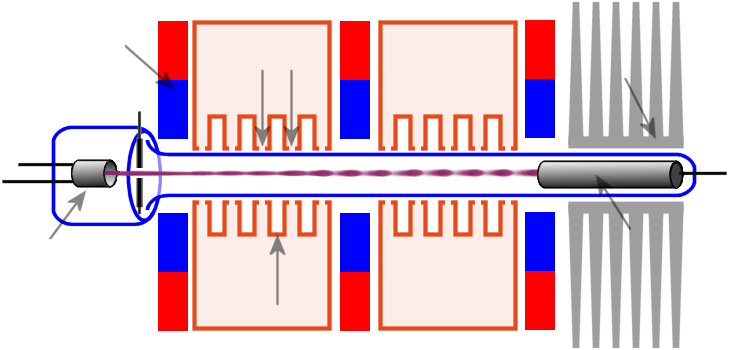Extended Interaction Klystron (EIK)

magnets
gaps
Figure 1: Principle of operation of an EIK

magnets
gaps
Figure 1: Principle of operation of an EIK

magnets
gaps
as Slow Wave Structure (SWS)
Figure 1: Principle of operation of an EIK
Extended Interaction Klystron (EIK) technology preserves the ruggedness and high power capability of the conventional Klystron. The EIK can be considered as a refinement of both two-cavity klystron and coupled-cavity TWT. The EIK is a velocity modulated tube as linear beam device which combines the advantages of both tubes, the ruggedness and high power capability of a klystron and the larger bandwidth of a TWT. It achieves enhanced power, bandwidth and efficiency at millimeter frequencies through the introduction of cavities with multiple coupled gaps. The number of cavities and interaction gaps can differ depending on required applications. A Ladder-type RF circuit supports high efficiency and thermal stability at millimeter and sub-millimeter frequencies, while operating with moderate electron beam voltages. The EIKs currently operate at frequencies from 18 to 280 GHz.
Figure 1 presents the principle of operation of an EIK; electrons are emitted from the cathode, a high convergence electron gun accelerates and focuses the cylindrical electron beam through an aperture in the anode. The electrons get a strong acceleration of the anode voltage and pass this electrode by a little hole in the anode. Beyond the anode, the linear beam, confined by the field of a permanent magnet, passes through a beam tunnel in the center of a series of cavities. Each cavity represents a short piece of the resonant slow-wave structure based on ladder geometry as like as the coupled cavities in a TWT. The number of SWS periods is selected to satisfy the conditions of RF stability and efficient beam modulation. The spent electron beam then leaves the circuit and is recovered in the depressed collector.
The multi-gap RF circuit has a simple, rugged geometry and is characterized by high impedance. This supports efficient modulation and energy exchange between the RF field and the electron beam over a broad instantaneous bandwidth.
High gain per length produces a short interaction circuit and provides the opportunity to use permanent magnets for focusing. The result is a well-focused electron beam in a relatively light package. In the case of pulsed operation, a focus electrode aperture grid is used to switch the beam. A short ladder length minimizes parasitic modes, and various methods for selective mode suppression ensure stable operation with low noise.
Extended Interaction Oscillator
The Extended Interaction Oscillator (EIO) is a single cavity device with interaction gaps that function like a coupled-cavity TWT with extremely strong cavity-to-cavity coupling. At sufficient high beam currents, oscillations are sustained. Variation of the beam voltage allows up to 0.4% frequency tuning.
